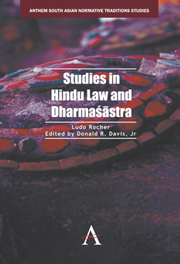Book contents
- Frontmatter
- Contents
- Foreword by Richard W. Lariviere
- Preface
- Abbreviations
- Note on the Edition
- Introduction
- PART ONE THE NATURE OF HINDU LAW
- Hindu Conceptions of Law
- The Historical Foundations of Ancient Indian Law
- Hindu Law and Religion: Where to Draw the Line
- Law Books in an Oral Culture: The Indian Dharmaśūstras
- Schools of Hindu Law
- Changing Patterns of Diversification in Hindu Law
- PART TWO GENERAL TOPICS OF HINDU LAW
- PART THREE HINDU LEGAL PROCEDURE
- PART FOUR TECHNICAL STUDIES OF HINDU LAW
- PART FIVE ANGLO-HINDU AND CUSTOMARY LAW
- Bibliography
- Index
Hindu Conceptions of Law
from PART ONE - THE NATURE OF HINDU LAW
Published online by Cambridge University Press: 05 February 2013
- Frontmatter
- Contents
- Foreword by Richard W. Lariviere
- Preface
- Abbreviations
- Note on the Edition
- Introduction
- PART ONE THE NATURE OF HINDU LAW
- Hindu Conceptions of Law
- The Historical Foundations of Ancient Indian Law
- Hindu Law and Religion: Where to Draw the Line
- Law Books in an Oral Culture: The Indian Dharmaśūstras
- Schools of Hindu Law
- Changing Patterns of Diversification in Hindu Law
- PART TWO GENERAL TOPICS OF HINDU LAW
- PART THREE HINDU LEGAL PROCEDURE
- PART FOUR TECHNICAL STUDIES OF HINDU LAW
- PART FIVE ANGLO-HINDU AND CUSTOMARY LAW
- Bibliography
- Index
Summary
Any discussion of Hindu conceptions of law has to start with the basic observation that nowhere in the Hindu tradition is there a term to express the concept of law, neither in the sense of ius nor in that of lex. Not until the arrival of the colonial powers was the concept of law used on the subcontinent, by Europeans and through the medium of European languages. It was not until 1772, the year in which it was decided that, “in all suits regarding inheritance, marriage, caste, and other religious usages or institution” (Acharyya 1914), the Hindus should be governed by their own laws, that an effort was made to study and translate the Sanskrit books in which the Hindu laws were codified. These books happen to be the Dharmasastras, treatises on dharma. Hence, the equation established by the Western editors and translators of these books was “dharma-śāstra” equals lawbook, code, or institute. They also established the equation: dharma equals law.
To be sure, Indians have followed this well-established practice. When it comes to expressing the concept of law in modern India through the medium of modern Indian languages, however, different terms are used. For instance, recent dictionaries of India's official language, Hindi, normally give two terms for law, one borrowed from the Arabic-Persian (Muslim) tradition, kānūn, and one from the Sanskrit (Hindu) tradition, vidhi. In addition, when the Indian Constitution was translated into Hindi, vidhi became the official translation for law, both in the text of the Constitution and in the English-Hindi wordlist published along with it by the Government of India.
- Type
- Chapter
- Information
- Studies in Hindu Law and Dharmasastra , pp. 39 - 58Publisher: Anthem PressPrint publication year: 2012
- 1
- Cited by



